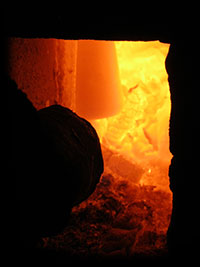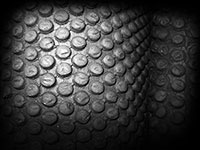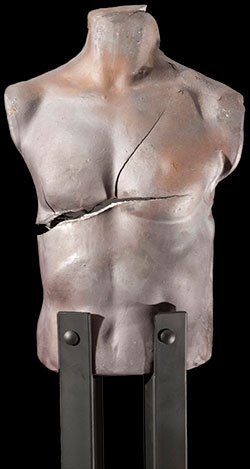Sensuality in Clay: Mike Rand’s Ceramic Sculptures
Colorado ceramic artist, Mike Rand, is only in his mid-thirties, so it might seem preposterous to say that he has three decades of work experience under his belt--but, none the less, it would be true.

“I started working in clay when I was five,” says Rand, “my mother would kick the wheel for me, and I remember firing wood kilns with my father at about the same time.”
Born in Leadville, Colorado in 1976, Rand attended school in Michigan but spent a good deal of his time each year in the Rockies. He lived in an A-frame cabin that his parents, artists themselves, had designed and built in Carbondale, not far from Aspen. This area was a fertile ground for a budding ceramic artist and as a child Rand was exposed to the work—and the work habits—of several significant potters and ceramic sculptors. Rand was particularly influenced by the late Thanos Johnson, a disciple of Shoji Hamada. “I learned raku from Thanos,” Rand recalls, “and when I was a teenager, I was gathering tall grasses and using them in the firings.” Also in the mix of influences at this time was another ceramic artist who worked nearby, the world renowned Paul Soldner.
Beginning in 1990 and continuing through ’94, Rand, who was still in high school at the time, studied ceramics at Michigan State University while, in the summers, he attended workshops around Aspen. For his undergraduate degree in material engineering at University of Michigan, Rand was mentored by the ceramic sculptor, Sadashi Inuzuka. Rand then attended Southern Cross University in Australia and he earned his Master of Arts there. At Southern Cross, Rand studied with Tony Nankervis, a master of wood-firing. At the time, Rand’s principle interest was developing what he calls “velvet clay” in which the iron oxide in the mixture comes back out of the solution when pieces are fired, creating what looks like glazes on the surfaces.

As may be surmised by this brief accounting of his extensive formal grounding in ceramics, Rand was early-on exposed to the Asian tradition, specifically, the Japanese current that dominated studio ceramics for most of the 20th century in the United States. As a result, up until the last few years, Rand created several bodies of work, divided between functional vessels, and sculptures that were vessel-based, all of which were derived from Japanese ideas.
Then Rand made a bold move in a new direction with the results, illustrated in this catalogue, revealing a marked change in his sensibility toward clay. Rand increasingly moved away from the Japanesque approach and began to embrace other traditions and to make them his own.
Early-on Rand had discovered the work of George Ohr, the so-called “Mad Potter of Biloxi” who worked a century ago. The smashed clay shapes and collapsed forms that Rand employs, owe their origins to Ohr’s example. More unusual, given his grounding in aesthetics derived from the Japanese sensibility, is Rand’s embrace of its countercurrent in the history of clay: the Mediterranean aesthetic. This is most obvious in his torso sculptures, that are meant to be self-portraits, and which have a Greco-Roman character, but is also evident in his more thoroughly abstract and surrealist confections that are meant to recall undersea life. His use of tendrils or spikes, for example, recalls the decorative flourishes of Italian modernist ceramics and glass.

The reconciling of Japanese ideas with Italian ones, which is easy to see in Rand’s work, is a contemporary movement in ceramic sculpture with perhaps its best known proponent being Betty Woodman who worked in Colorado for nearly half a century. How Rand made this sudden turn can only be explained by his recent exposure to the masters of Italian craft during the time he worked in a gallery in Aspen. “It was Lino,” Rand says by way of explanation, referring to Venetian glass master Lino Tagliapietro whose creations were a mainstay of the gallery.
Finally, there’s an undeniable sexuality in the forms of these recent pieces. The torsos, depicting lithe and athletic men, are quietly sensual. The surrealist sea creature sculptures, on the other hand, are more thoroughly erotic, abounding in both phallic and vaginal imagery, though the referents are essentially subliminal and evocative, as opposed to being literal.
Mike Rand’s most recent efforts featured on the following pages reveal the vast array of artistic forces that have guided him over the years. These courageous and technically ambitious pieces demonstrate the artist’s longtime commitment to beauty and, at the same time, to endless experimentation.
--Michael Paglia
Art Critic, Westword, Denver, Colorado
 ArtAscent Art & Literature Journal
ArtAscent Art & Literature Journal
December 2013, Volume 4
Peculiar organic sculptures invented by Michael Rand instantly awaken the emotions of unease and curiosity. The initial impression incites the association to the terrifying designs of H.R. Giger, the mastermind behind the phantasmagoric image of Ridley Scott’s “Alien.” Rand’s figures are strange and puzzling, reminiscent of the familiar, but unlike Giger’s openly villainous creatures, they are unthreatening and calmly present.
Naming this body of work “thoughts, Dreams and Entities,” the artist refers to the thoughts, dreams and entities “one finds during the darkness of dream-time states, “the occurrences we, the humans, are conditioned to fear due to their obscure nature. Inspiration for these imaginary life-forms has come to their creator during the contemplation on the realm of subconscious. Epitomizing the premise that certain “primordial creatures” dwell in the darkness of our subconscious selves, Rand, in the manner of the 20th century Surrealists, ponders on these darkest depths of the oneiric state and extracts the most intriguing manifestations of the mind into the light. The revelation of the artist’s authentic vision conveys the message that “those whom choose to embrace the darkness from deep within the dream-time discover the glow of the deepest thoughts that race across one’s inner regions of one’s mind.” This path of self recognition should culminate in enlightenment through liberation from fear, because understanding of the nature of the most classified thoughts provides the explanation of the fear-provoking unknown.
Humanoid and nuclear forms executed in Rand’s material exude their ethereal nature through reduced use of colour and the emphasis on texture. Soft and long fluid shapes portray the motion of primordial creatures traveling through the mind faster than the speed of light, crossing over the synapse bridges constructed by the use of electro-luminescent wire. The human torso of “Quantum Thoughts Within” is cracked, overwhelmed by the weight of the internal turmoil, while the “Dream Hunter Crossing Over” is breaking out into the new enlightened human entity.
Through implementation of the enhanced materials, the artist has succeeded in creating works that stimulate meditation on the buried subjects we usually avoid. The truth behind them tells that one human being can only become aware of his or her own self by consciously going through the storm of his own anxieties and furthermore, that a person can only discover the glow of pristine wisdom by fully grasping the inner darkness within his or her own innermost being.
Michael Rand is a ceramic artist from Carbondale, Colorado. He has presented his work in numerous exhibitions in the U.S. and Australia. Among the awards he has won is the latest CLAY 2013 Award of Firehouse Art Center of Norman, Oklahoma. Since 2000 Rand has been working as a fine arts photographer focusing on fine landscape, abstract and motorsports photography.
By Ana Bambic Kostov, ArtAscent Writer, Art Historian/Critic, International Council of Museums Member





